
Caribbean Dreams – Cabo Rojo, Bonaire, Curaçao, and Aruba!
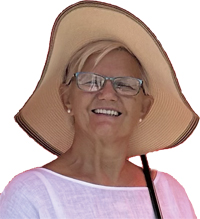
As golden sunlight painted Florida’s highways, we drove from Palm Coast to Fort Lauderdale, brimming with anticipation. After weeks of planning, we settled into our nicely furnished and newly renovated pre-cruise accommodations at Fairfield Inn & Suites, our car tucked safely away for the duration of our adventure. The next day would launch our 10-day Caribbean journey aboard Holland America Line’s ms Eurodam, a refined Signature-class vessel that had already charmed us on previous voyages. Our capable captain was Captain Jeroen van Donselaar, an extraordinary professional who provided a seamless experience.
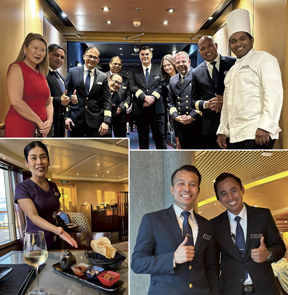 Embarkation flowed effortlessly, and we nestled into our suite, secured through a paid upgrade, under the attentive care of our ever-present stewards, Kadek and Frans. Excitement bubbled up at the prospect of exploring five distinct Caribbean destinations, four of which we would visit for the first time. Our floating home would guide us through an enticing itinerary: Half Moon Cay, Cabo Rojo, Bonaire, Curaçao, and Aruba.
Embarkation flowed effortlessly, and we nestled into our suite, secured through a paid upgrade, under the attentive care of our ever-present stewards, Kadek and Frans. Excitement bubbled up at the prospect of exploring five distinct Caribbean destinations, four of which we would visit for the first time. Our floating home would guide us through an enticing itinerary: Half Moon Cay, Cabo Rojo, Bonaire, Curaçao, and Aruba.
Paradise welcomed us first at Half Moon Cay, Holland America’s private Bahamian retreat. This pristine sanctuary has dominated Porthole Cruise Magazine’s Best Private Island awards for two decades, though MSC’s Ocean Cay island now offers fresh competition. We spent a couple of blissful hours on powder-soft beaches caressed by crystal waters, setting an impressive standard for the adventures ahead.
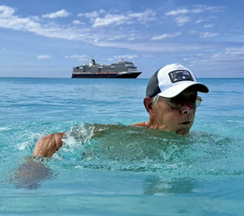 Our first couple of sea days on board allowed us to explore the ship’s amenities and embrace the rhythm of cruise life, though with an amusing early morning lesson. After dutifully hanging our room service breakfast order before 2 AM, Yusuf arrived promptly at 6 AM. My husband, still deep in slumber, was less than pleased to discover we’d overlooked the time zone change. I couldn’t help but grin at our minor miscalculation.
Our first couple of sea days on board allowed us to explore the ship’s amenities and embrace the rhythm of cruise life, though with an amusing early morning lesson. After dutifully hanging our room service breakfast order before 2 AM, Yusuf arrived promptly at 6 AM. My husband, still deep in slumber, was less than pleased to discover we’d overlooked the time zone change. I couldn’t help but grin at our minor miscalculation.
Cabo Rojo, Dominican Republic, unveiled our next adventure. This gleaming new cruise port showcases the country’s flourishing tourism development since gaining independence in 1844. 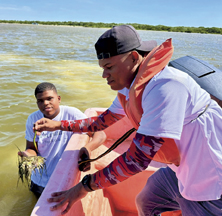 During our visit, I encountered two German students who were contributing to local tourism initiatives in exchange for room, board, and pocket money, which was an unexpected glimpse into sustainable tourism practices.
During our visit, I encountered two German students who were contributing to local tourism initiatives in exchange for room, board, and pocket money, which was an unexpected glimpse into sustainable tourism practices.
Our excursion whisked us to Laguna de Oviedo, a vast saltwater lagoon within Jaragua National Park’s UNESCO Biosphere Reserve. Our guide, Wellinton Valdez Rubio, navigated smaller passenger boats through shallow, limestone-tinted waters to one of 24 small islands. Here, on the only island accessible to tourists, we fed endangered Rhinoceros Iguanas bananas.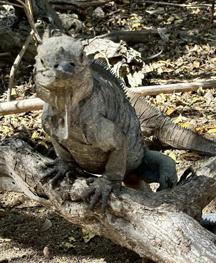 The thrill of being surrounded by several of these mini dragons was unforgettable. We approached as close as possible to pink Flamingos feeding in the shallow waters until they majestically rose in flight. Our guide explained that over a hundred bird species inhabit the area, including Roseate Spoonbills and White Ibises. Nothing beats watching these graceful birds in their natural habitat. The return journey turned adventurous when our antiquated bus’s failed air conditioning caused an impromptu sauna experience, something we could laugh about after reviving ourselves with cold showers back on board.
The thrill of being surrounded by several of these mini dragons was unforgettable. We approached as close as possible to pink Flamingos feeding in the shallow waters until they majestically rose in flight. Our guide explained that over a hundred bird species inhabit the area, including Roseate Spoonbills and White Ibises. Nothing beats watching these graceful birds in their natural habitat. The return journey turned adventurous when our antiquated bus’s failed air conditioning caused an impromptu sauna experience, something we could laugh about after reviving ourselves with cold showers back on board.
The ABC Islands, first spotted by Spanish explorer Alonso de Ojeda in 1499, revealed their rich Dutch heritage next. Bonaire welcomed us with its characteristic warmth as we cruised its celebrated waterfront aboard the Sea Breeze double-decker power catamaran. 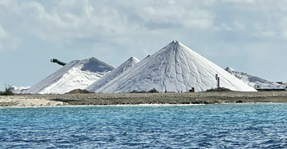 We passed huge white mountains of salt while our guide explained the salt production process. The catamaran approached the uninhabited island of Klein Bonaire through the famous Bonaire Marine Park. Its protected reef makes it a divers’ paradise. Here, grateful for every cloud, we sunbathed on Bonaire’s most attractive white-sand beach. Later that afternoon, after a nice lunch on board, we walked the town and had a great iced coffee at ‘Oh! Berry’.
We passed huge white mountains of salt while our guide explained the salt production process. The catamaran approached the uninhabited island of Klein Bonaire through the famous Bonaire Marine Park. Its protected reef makes it a divers’ paradise. Here, grateful for every cloud, we sunbathed on Bonaire’s most attractive white-sand beach. Later that afternoon, after a nice lunch on board, we walked the town and had a great iced coffee at ‘Oh! Berry’.
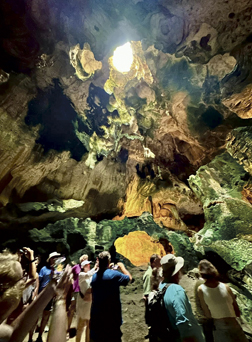 Curaçao’s colonial legacy unfolded for us when we climbed up to the Hato Caves, where ancient Caiquetio Indian markings date back 1,500 years. Despite the cave’s warmth, its limestone formations, including the famous Madonna statue, and the resident fruit bats, captivated us. Later, Willemstad’s UNESCO-listed historic center dazzled us with its iconic merchant houses, their vibrant hues reflecting Dutch-Caribbean heritage along the waterfront. The Punda Love Hearts at Handelskade offer a perfect photo opportunity, with three large steel lattice hearts hanging full of intertwined love locks from around the world, situated right next to the floating Queen Emma Bridge. Since 1888, this majestic bridge has swung back and forth to allow large ships to enter the Schottegat port in Willemstad. Stretching 548 feet across the St. Anna Bay, the bridge welcomes both curious travelers and container ships alike.
Curaçao’s colonial legacy unfolded for us when we climbed up to the Hato Caves, where ancient Caiquetio Indian markings date back 1,500 years. Despite the cave’s warmth, its limestone formations, including the famous Madonna statue, and the resident fruit bats, captivated us. Later, Willemstad’s UNESCO-listed historic center dazzled us with its iconic merchant houses, their vibrant hues reflecting Dutch-Caribbean heritage along the waterfront. The Punda Love Hearts at Handelskade offer a perfect photo opportunity, with three large steel lattice hearts hanging full of intertwined love locks from around the world, situated right next to the floating Queen Emma Bridge. Since 1888, this majestic bridge has swung back and forth to allow large ships to enter the Schottegat port in Willemstad. Stretching 548 feet across the St. Anna Bay, the bridge welcomes both curious travelers and container ships alike.
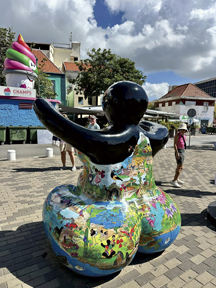 Aruba, our final port and the most autonomous ABC island since 1986, greeted us with an unexpected industrial, maritime view—an oil rig that fascinated Marcus, showcasing what I playfully dub his ‘typical guy’ interests. During our HAL bus excursion, we explored the otherworldly Casibari Rock Formation with its massive tonalite boulders. For such a relatively flat island, these unusual hills and huge monolithic boulders truly are an enigma. Walking trails and steps through the boulders allowed us to reach the top for breathtaking 360-degree views.
Aruba, our final port and the most autonomous ABC island since 1986, greeted us with an unexpected industrial, maritime view—an oil rig that fascinated Marcus, showcasing what I playfully dub his ‘typical guy’ interests. During our HAL bus excursion, we explored the otherworldly Casibari Rock Formation with its massive tonalite boulders. For such a relatively flat island, these unusual hills and huge monolithic boulders truly are an enigma. Walking trails and steps through the boulders allowed us to reach the top for breathtaking 360-degree views.
From there, we visited the poignant ‘Baby Natural Bridge’. After Aruba’s largest and most popular Natural Bridge collapsed in 2005, shocking both locals and visitors alike, this smaller formation became a must-see attraction. Its accessibility and nearby tourist amenities, including food, restrooms, and souvenirs, make it particularly appealing. We found serenity at Alto Vista Chapel, Aruba’s first Roman Catholic Church, established in 1750 by Caquetio natives and Spanish settlers. The chapel’s original construction, led by Venezuelan missionary Domingo Antonio Silvestre, featured stone walls and a straw roof. It was dedicated to Mother Mary, known as the ‘Mother of the Rosary.’
Our journey concluded at the California Lighthouse, traversing arid landscapes dotted with cacti, divi-divi trees, and occasional wildlife. Named after the ill-fated steamship S.S. California, which met its demise near the island’s coast in 1891, the lighthouse was constructed from 1915-1916. Though retired from its navigational duties, it stands as a cherished historical landmark offering visitors spectacular 360-degree island views.
I must mention our outstanding dining experiences aboard Eurodam. The Main Dining Room delivered exceptional service through our waiter Leo, the wonderful Maître d’s team (Damian, Noel, Suta, & WahyuWahyu) and the personal attention of Stefan Miles, the handsome Food & Beverage Director. But the Tamarind specialty restaurant hit the jackpot with its creative cuisine by Chef Nur Hadi, and our highly entertaining waitress Ing-Ing and her team.
Until next month from another interesting location.
— Yours in travel, Ingrid
Escape From Paradise: www.EscapeFromParadise.net
www.facebook.com/ingrid.lemme #EscapeFromParadise
Award-winning TV Host, Publisher, Travel Writer.
Ambassador for www.Seven-Stars.com & 15 Emmy awards www.aTasteofHistory.org
www.twitter.com/LemmeEscape www.instagram.com/ingridlemme

